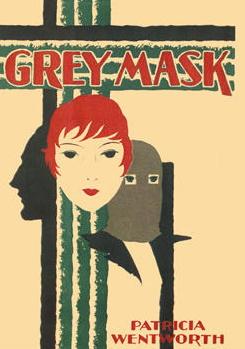 Cover of the first American edition.
Cover of the first American edition.
Book Review by George S: Charles Moray comes back from four years abroad, and is surprised to find that his empty house is being used as the meeting-place of a criminal gang, led by a terrifying man in a gray mask. He is even more concerned to find that his ex-fiancée, Margaret, seems to be involved in the evil plotting.
The gang’s current scheme is to obtain the legacy due to an heiress by stealing her father’s will and proving her to be illegitimate, thus robbing her of the right to inherit.
Confused and concerned, and unwilling to contact the police because of Margaret’s involvement, Charles decides to call on a private detective, Miss Silver:
Charles entered Miss Silver’s office with a good deal of curiosity, and found himself in a small, light room, very bare – furnished to the first glance at any rate, by a chair, a writing-table and Miss Silver herself. The writing-table was immense, of the large old-fashioned flat kind with drawers all round it; the top was piled high with exercise-books of different colours very neatly stacked. Miss Silver sat in front of a pad of pink blotting-paper. She was a little person with no features, no complexion, and a great deal of tidy mouse-coloured hair done in a large bun at the back of her head. She inclined her head slightly, but did not offer to shake hands.
During the course of the novel, we will see very little of Miss Silver doing any actual detecting. It is Charles and Margaret who will stumble from adventure to adventure. But whenever Charles visits Miss Silver, she knows exactly what is going on, and has been out investigating, unknown to anyone else. This is the first of Wentworth’s series of Miss Silver novels, and the detective makes a very impressive start.
This book shows the best and worst of Patricia Wentworth’s characteristics as a writer. It is fast-moving and involving, and the cliff-hangers are frequent and well-managed. On the other hand, the plot is flimsy, and the criminal conspiracy is far from believable. The revelation of Grey Mask’s identity towards the end will come as little surprise to devotees of crime fiction, though it may have seemed more original in 1928. The conventions of whodunit reviewing demand that I should not say too much about the revelation, but I’ll just hint that Wentworth distracts the reader with a literary trick used to even better effect by Agatha Christie in The Seven Dials Mystery (1929).
She enlivens the chases and investigations with comedy. Two characters especially are defined by their rather enjoyable speech patterns. Freddy, Margaret’s step-father has a way of talking that continually drifts off the subject into irrelevancies. Even more enjoyable is the endangered heiress, who babbles continually is wonderfully stupid, especially about her own safety.
By these means, Patricia Wentworth keeps the story bubbling along, so that you hardly notice the implausibility of the conspiracy or the holes in the plotting.
This is the fourth Wentworth I have read, and the one I have enjoyed most. I like the way she uses Miss Silver, as a kind of guardian angel in the background, looking after her clients in ways that they are not fully aware of. The books without Miss Silver seem thinner. I recently read Outrageous Fortune (1933), a novel about a man who has lost his memory. The amnesia (like most fictional memory-loss) was quite unrelated to the reality of actual medical cases of amnesia, and the evil conspiracy was even more far-fetched than the one in Grey Mask.
Patricia Wentworth, it seems to me, is an entertaining writer, but not quite in the first class of detective novelists. She lacks the ruthlessness of Agatha Christie, in whose books no-one is safe from suspicion, and where the revelations can utterly overturn the reader’s expectations. I’ll probably read some more Wentworths in the future. Excellent comfort reading when you’re ill, I suspect.
